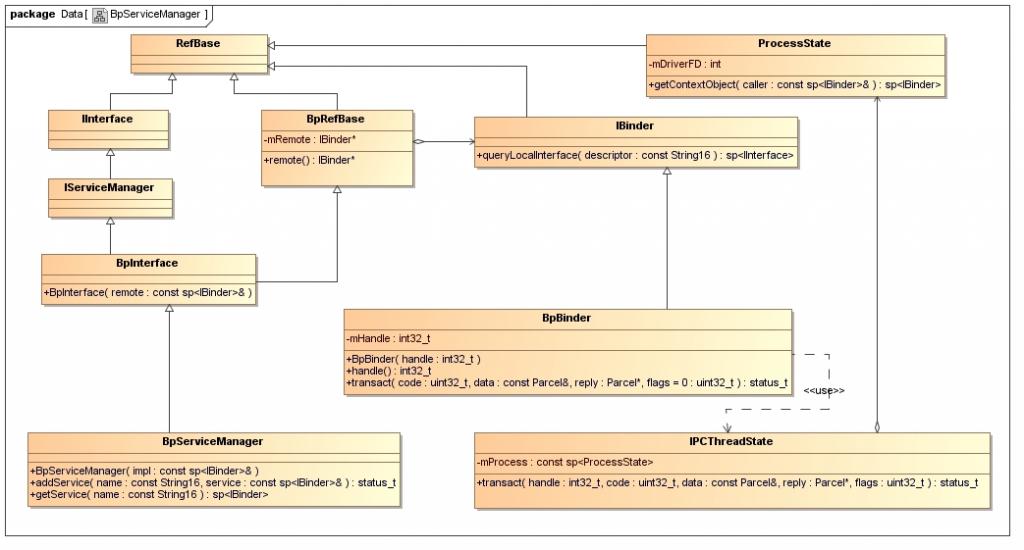《Android系统源代码情景分析》一书正在进击的程序员网(http://0xcc0xcd.com)中连载,点击进入!
在阅读本文之前,希望读者先阅读Android进程间通信(IPC)机制Binder简要介绍和学习计划一文提到的参考资料Android深入浅出之Binder机制,这样可以加深对本文的理解。
我们知道,Service Manager在Binder机制中既充当守护进程的角色,同时它也充当着Server角色,然而它又与一般的Server不一样。对于普通的Server来说,Client如果想要获得Server的远程接口,那么必须通过Service Manager远程接口提供的getService接口来获得,这本身就是一个使用Binder机制来进行进程间通信的过程。而对于Service Manager这个Server来说,Client如果想要获得Service Manager远程接口,却不必通过进程间通信机制来获得,因为Service Manager远程接口是一个特殊的Binder引用,它的引用句柄一定是0。
获取Service Manager远程接口的函数是defaultServiceManager,这个函数声明在frameworks/base/include/binder/IServiceManager.h文件中:
实现在frameworks/base/libs/binder/IServiceManager.cpp文件中:
gDefaultServiceManagerLock和gDefaultServiceManager是全局变量,定义在frameworks/base/libs/binder/Static.cpp文件中:
从这个函数可以看出,gDefaultServiceManager是单例模式,调用defaultServiceManager函数时,如果gDefaultServiceManager已经创建,则直接返回,否则通过interface_cast<IServiceManager>(ProcessState::self()->getContextObject(NULL))来创建一个,并保存在gDefaultServiceManager全局变量中。
在继续介绍interface_cast<IServiceManager>(ProcessState::self()->getContextObject(NULL))的实现之前,先来看一个类图,这能够帮助我们了解Service Manager远程接口的创建过程。

参考资料Android深入浅出之Binder机制一文的读者,应该会比较容易理解这个图。这个图表明了,BpServiceManager类继承了BpInterface<IServiceManager>类,BpInterface是一个模板类,它定义在frameworks/base/include/binder/IInterface.h文件中:
IServiceManager类继承了IInterface类,而IInterface类和BpRefBase类又分别继承了RefBase类。在BpRefBase类中,有一个成员变量mRemote,它的类型是IBinder*,实现类为BpBinder,它表示一个Binder引用,引用句柄值保存在BpBinder类的mHandle成员变量中。BpBinder类通过IPCThreadState类来和Binder驱动程序并互,而IPCThreadState又通过它的成员变量mProcess来打开/dev/binder设备文件,mProcess成员变量的类型为ProcessState。ProcessState类打开设备/dev/binder之后,将打开文件描述符保存在mDriverFD成员变量中,以供后续使用。
理解了这些概念之后,就可以继续分析创建Service Manager远程接口的过程了,最终目的是要创建一个BpServiceManager实例,并且返回它的IServiceManager接口。创建Service Manager远程接口主要是下面语句:
首先是调用ProcessState::self函数,self函数是ProcessState的静态成员函数,它的作用是返回一个全局唯一的ProcessState实例变量,就是单例模式了,这个变量名为gProcess。如果gProcess尚未创建,就会执行创建操作,在ProcessState的构造函数中,会通过open文件操作函数打开设备文件/dev/binder,并且返回来的设备文件描述符保存在成员变量mDriverFD中。
接着调用gProcess->getContextObject函数来获得一个句柄值为0的Binder引用,即BpBinder了,于是创建Service Manager远程接口的语句可以简化为:
再来看函数interface_cast<IServiceManager>的实现,它是一个模板函数,定义在framework/base/include/binder/IInterface.h文件中:
这里的INTERFACE是IServiceManager,于是调用了IServiceManager::asInterface函数。IServiceManager::asInterface是通过DECLARE_META_INTERFACE(ServiceManager)宏在IServiceManager类中声明的,它位于framework/base/include/binder/IServiceManager.h文件中:
展开即为:
IServiceManager::asInterface的实现是通过IMPLEMENT_META_INTERFACE(ServiceManager, "android.os.IServiceManager")宏定义的,它位于framework/base/libs/binder/IServiceManager.cpp文件中:
展开即为:
估计写这段代码的员工是从Microsoft跳槽到Google的。这里我们关注IServiceManager::asInterface的实现:
这里传进来的参数obj就则刚才创建的new BpBinder(0)了,BpBinder类中的成员函数queryLocalInterface继承自基类IBinder,IBinder::queryLocalInterface函数位于framework/base/libs/binder/Binder.cpp文件中:
由此可见,在IServiceManager::asInterface函数中,最终会调用下面语句:
即为:
回到defaultServiceManager函数中,最终结果为:
这样,Service Manager远程接口就创建完成了,它本质上是一个BpServiceManager,包含了一个句柄值为0的Binder引用。
在Android系统的Binder机制中,Server和Client拿到这个Service Manager远程接口之后怎么用呢?
对Server来说,就是调用IServiceManager::addService这个接口来和Binder驱动程序交互了,即调用BpServiceManager::addService 。而BpServiceManager::addService又会调用通过其基类BpRefBase的成员函数remote获得原先创建的BpBinder实例,接着调用BpBinder::transact成员函数。在BpBinder::transact函数中,又会调用IPCThreadState::transact成员函数,这里就是最终与Binder驱动程序交互的地方了。回忆一下前面的类图,IPCThreadState有一个PorcessState类型的成中变量mProcess,而mProcess有一个成员变量mDriverFD,它是设备文件/dev/binder的打开文件描述符,因此,IPCThreadState就相当于间接在拥有了设备文件/dev/binder的打开文件描述符,于是,便可以与Binder驱动程序交互了。
对Client来说,就是调用IServiceManager::getService这个接口来和Binder驱动程序交互了。具体过程上述Server使用Service Manager的方法是一样的,这里就不再累述了。
IServiceManager::addService和IServiceManager::getService这两个函数的具体实现,在下面两篇文章中,会深入到Binder驱动程序这一层,进行详细的源代码分析,以便更好地理解Binder进程间通信机制,敬请关注。





















 1421
1421











 被折叠的 条评论
为什么被折叠?
被折叠的 条评论
为什么被折叠?








